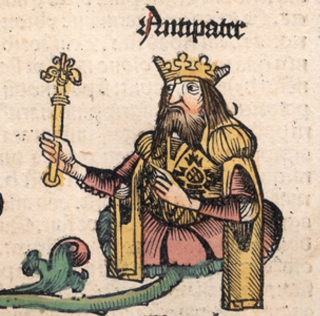Herod I or Herod the Great was a Roman Jewish client king of the Herodian kingdom of Judea. He is known for his colossal building projects throughout Judea. Among these works are the rebuilding of the Second Temple in Jerusalem and the expansion of its base—the Western Wall being part of it. Vital details of his life are recorded in the works of the 1st century CE Roman–Jewish historian Josephus.

Herod Agrippa, also known as Herod II or Agrippa I, was the last king of Judea. He was a grandson of Herod the Great and the father of Herod Agrippa II, the last known king from the Herodian dynasty. He was an acquaintance or friend of Roman emperors and played crucial roles in internal Roman politics.

Herod Agrippa II, officially named Marcus Julius Agrippa and sometimes shortened to Agrippa, was the last ruler from the Herodian dynasty, reigning over territories outside of Judea as a Roman client. Agrippa II fled Jerusalem in 66, fearing the Jewish uprising, and he supported the Roman side in the First Jewish–Roman War.

The Hasmonean dynasty was a ruling dynasty of Judea and surrounding regions during the Hellenistic times of the Second Temple period, from c. 140 BCE to 37 BCE. Between c. 140 and c. 116 BCE the dynasty ruled Judea semi-autonomously in the Seleucid Empire, and from roughly 110 BCE, with the empire disintegrating, Judea gained further autonomy and expanded into the neighboring regions of Perea, Samaria, Idumea, Galilee, and Iturea. The Hasmonean rulers took the Greek title basileus ("king") as the kingdom became a regional power for several decades. Forces of the Roman Republic intervened in the Hasmonean Civil War in 63 BCE and made it into a client state, marking the decline of Hasmonean dynasty; Herod the Great displaced the last reigning Hasmonean client-ruler in 37 BCE.

Herodias was a princess of the Herodian dynasty of Judaea during the time of the Roman Empire. Christian writings connect her with the execution of John the Baptist.

Antipater I the Idumaean was the founder of the Herodian dynasty and father of Herod the Great. According to Josephus, he was the son of Antipas and had formerly held that name. A native of Idumaea Antipater became a powerful official under the later Hasmonean kings and subsequently became a client of Roman General Pompey when Pompey conquered Judah in the name of the Roman Republic.
The Boethusians were a Jewish sect closely related to, if not a development of, the Sadducees.
The Herodians were a sect of Hellenistic Jews mentioned in the New Testament on two occasions – first in Galilee and later in Jerusalem – being hostile to Jesus. In each of these cases their name is coupled with that of the Pharisees.

Herod Archelaus was the ethnarch of Samaria, Judea, and Idumea, including the cities Caesarea and Jaffa, for nine years. He was the son of Herod the Great and Malthace the Samaritan, brother of Herod Antipas, and half-brother of Herod II. Archelaus came to power after the death of his father Herod the Great in 4 BC, and ruled over one-half of the territorial dominion of his father. Archelaus was removed by the Roman emperor Augustus when Judaea province was formed under direct Roman rule, at the time of the Census of Quirinius.

Julia Drusilla was a daughter of Herod Agrippa and Cypros. Her siblings were Berenice, Mariamne, and Herod Agrippa II. Her son Agrippa was one of the few people known by name to have died in the eruption of Mount Vesuvius in 79 AD.

Mariamne I, also called Mariamne the Hasmonean, was a Hasmonean princess and the second wife of Herod the Great. Her parents, Alexandra Maccabeus and Alexander of Judaea, were cousins who both descended from Alexander Jannaeus. She was known for her great beauty, as was her brother Aristobulus III. Herod's fear of his Hasmonean rivals led him to execute all of the prominent members of the family, including Mariamne.

Antipater II was Herod the Great's first-born son, his only child by his first wife Doris. He was named after his paternal grandfather Antipater the Idumaean. He and his mother were exiled after Herod divorced her between 43 BC and 40 BC to marry Mariamne I. However, he was recalled following Mariamne's fall in 29 BC and in 13 BC Herod made him his first heir in his will. He retained this position even when Alexander and Aristobulus rose in the royal succession in 12 BC, and even became exclusive successor to the throne after their execution in 7 BC.
Herod II was the son of Herod the Great and Mariamne II, the daughter of Simon Boethus the High Priest, and the first husband of Herodias, daughter of Aristobulus IV and his wife Berenice. For a brief period he was his father's heir apparent, but Herod I removed him from succession in his will. Some writers call him Herod Philip I, as the Gospel of Matthew and Gospel of Mark state that Herodias was married to a "Philip". Because he was the grandson of Simon Boethus, he is sometimes also called Herod Boethus, but there is no evidence he was actually thus called during his lifetime.
Costobarus was an associate of Herod the Great and second husband of Herod's sister Salome I. He was also known as Costobar.
Ananelus was a Jewish High priest in the 1st century BCE.

Jesus son of Damneus was a Herodian-era High Priest of Judaea in Jerusalem, Iudaea Province.

The Herodian kingdom was a client state of the Roman Republic ruled from 37 to 4 BCE by Herod the Great, who was appointed "King of the Jews" by the Roman Senate. When Herod died, the kingdom was divided among his sons into the Herodian Tetrarchy.
Simon, son of Boethus was a Jewish High priest in the 1st century BCE and father-in-law of Herod the Great. According to Josephus, he was also known by the name Cantheras. His family is believed to have been connected to the school of the Boethusians, and a family whose origins are from Alexandria in Egypt.
The family of Boethos produced many High Priests of Israel. They may have been related to the Boethusians.










